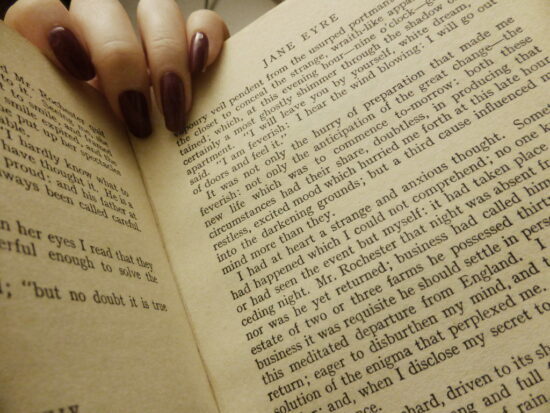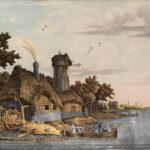Plot and Storyline
Jane Eyre, written by Charlotte Bronte and published in 1847, is a classic novel that follows the life of its eponymous protagonist. The story begins with Jane as a young orphan living with her unloving aunt and cousins, who treat her with cruelty. Jane is eventually sent to Lowood School, a charity institution for girls, where she endures harsh conditions but receives an education.
After her time at Lowood, Jane becomes a governess at Thornfield Hall, where she meets Mr. Rochester, the brooding and enigmatic master of the house. Jane develops a deep emotional connection with Mr. Rochester, but their relationship is complicated by secrets and obstacles. As Jane uncovers the truth about Mr. Rochester’s past and his hidden secret, she faces a moral dilemma that challenges her principles and desires for love and happiness.
The novel takes readers through Jane’s journey of self-discovery, as she learns to navigate societal expectations, grapples with her own identity and desires, and ultimately finds her own voice and independence. It explores themes of love, morality, social class, and gender roles, presenting a story that is both a Bildungsroman and a romance.
Characters
Jane Eyre is a complex and dynamic character. As the protagonist, she undergoes significant personal growth and transformation throughout the novel. Jane is depicted as a passionate and fiercely independent woman who values her own principles and refuses to be constrained by societal expectations. Her journey is marked by her quest for love, belonging, and self-fulfillment.
Mr. Rochester, the male lead, is a brooding and mysterious figure who initially captivates Jane. He is haunted by a troubled past and his own personal demons. Mr. Rochester’s complex nature and the revelation of his secret create a moral dilemma for Jane, forcing her to confront her own values and make difficult choices.
Other significant characters include Helen Burns, Jane’s close friend at Lowood School, who influences her with her stoic and devout nature; St. John Rivers, a clergyman who represents the strict adherence to duty and societal expectations; and Bertha Mason, Mr. Rochester’s first wife, who is hidden away in the attic and serves as a symbol of the consequences of societal restrictions on women.
Themes and Symbols
Jane Eyre explores several major themes that resonate throughout the novel. One central theme is the search for identity and self-worth. Jane constantly grapples with questions of who she is and her place in the world. She seeks validation and struggles with societal expectations, ultimately coming to embrace her own individuality and moral compass.
Another significant theme is the exploration of love and passion. Jane’s relationship with Mr. Rochester challenges traditional notions of romance and societal expectations. It delves into the complexities of love, highlighting the importance of emotional connection, equality, and personal integrity in relationships.
The novel also addresses the themes of social class and gender roles. Jane, as a woman of lower social standing, faces numerous obstacles and societal prejudices. Bronte critiques the rigid social hierarchy of the Victorian era, highlighting the injustices and limitations imposed on individuals based on their class and gender.
Symbols play a crucial role in Jane Eyre. The red room, where Jane is locked as a child, represents her imprisonment and isolation. Thornfield Hall, with its dark secrets, serves as a symbol of the hidden complexities within individuals and society. The motif of fire symbolizes both destruction and rebirth, reflecting Jane’s journey of self-discovery and transformation.
Writing Style
Charlotte Bronte’s writing style in Jane Eyre is characterized by its emotional intensity, vivid descriptions, and introspective narrative. She employs a first-person perspective through Jane’s voice, allowing readers to intimately experience her thoughts, emotions, and inner conflicts.
Bronte’s use of language is rich and poetic, employing metaphors, similes, and sensory details to evoke powerful imagery. Her prose is often impassioned and lyrical, heightening the emotional impact of the story. For example, the famous line, “I am no bird; and no net ensnares me,” encapsulates Jane’s defiance and rejection of societal constraints.
The narrative structure of Jane Eyre follows a chronological progression, with occasional flashbacks to Jane’s childhood. Bronte employs foreshadowing and suspense to engage readers and maintain tension throughout the story. The pacing is deliberate, allowing for the exploration of complex themes and the gradual development of characters.
Setting and Atmosphere
The setting of Jane Eyre plays a significant role in establishing the novel’s tone and atmosphere. The story is primarily set in England during the early 19th century, a time marked by strict social norms and gender expectations. The contrasting settings of Gateshead, Lowood School, Thornfield Hall, and Moor House reflect Jane’s progression from oppression to liberation.
The atmospheric descriptions contribute to the overall mood of the novel. The somber and gloomy atmosphere of Thornfield Hall mirrors Jane’s internal struggles and the secrets that lie within the mansion. Themoors surrounding Moor House evoke a sense of wildness and freedom, serving as a backdrop for Jane’s self-discovery and her search for independence.
Historical, Social, or Political Context
Jane Eyre was written during the Victorian era, a period characterized by strict social conventions and gender roles. Bronte’s novel challenges these societal norms and offers a critique of the limitations imposed on women.
During this time, women were expected to conform to domestic roles and marry for social advancement rather than love. Jane Eyre subverts these expectations by presenting a strong, independent female protagonist who refuses to compromise her principles for societal acceptance.
The novel also addresses issues of social class. Jane’s position as a governess places her in a precarious social position, neither fully belonging to the upper class nor the lower class. Bronte explores the disparities and prejudices between different social strata, highlighting the challenges faced by individuals who do not fit neatly into societal hierarchies.
In addition to its social commentary, Jane Eyre reflects the religious and moral climate of the Victorian era. The novel explores themes of duty, piety, and the conflict between personal desires and religious obligations through the character of St. John Rivers.
Impact and Reception
Jane Eyre has had a profound impact on literature and continues to be widely read and studied. At the time of its publication, it received mixed reviews, with some critics objecting to its unconventional portrayal of female desire and its moral ambiguity. However, it also garnered significant attention and sparked discussions about social issues and women’s rights.
Over time, Jane Eyre has become recognized as a literary masterpiece and a feminist classic. It has been praised for its exploration of female agency, individuality, and the search for personal fulfillment. The novel’s enduring popularity can be attributed to its relatable and complex characters, its timeless themes, and its powerful storytelling.
Jane Eyre has influenced subsequent works of literature, serving as a source of inspiration for authors exploring similar themes of love, identity, and societal constraints. It has been adapted into numerous film, television, and stage adaptations, further cementing its cultural significance.
Final Conclusions
Jane Eyre by Charlotte Bronte is a timeless novel that continues to captivate readers with its compelling storyline, richly drawn characters, and thought-provoking themes. Bronte’s exploration of love, identity, and societal expectations challenges Victorian norms and offers a powerful portrayal of a woman’s journey towards self-discovery and independence.
Through its vivid descriptions, emotional intensity, and introspective narrative, Jane Eyre invites readers into the inner world of its protagonist, allowing them to experience her struggles, desires, and triumphs. The novel’s enduring legacy lies in its ability to resonate with readers across generations, inspiring discussions about gender, social class, and personal autonomy.
Jane Eyre remains an important work in the canon of English literature, and its impact on subsequent literature and popular culture is a testament to its enduring relevance. As readers continue to engage with Jane’s story, they are reminded of the timeless quest for self-acceptance, love, and the pursuit of one’s own path in life.
What are some more examples of symbols in Jane Eyre and their significance?
In addition to the symbols mentioned earlier, here are a few more examples of symbols in Jane Eyre and their significance:
1. The Governess Position: The role of the governess in the novel serves as a symbol of the liminal space between the upper and lower classes. As a governess, Jane occupies a social position that is neither fully a servant nor a member of the family. This symbolizes her own ambiguous social standing and the challenges she faces in navigating the rigid class hierarchy of Victorian society.
2. Eyre’s Name: Jane’s surname, Eyre, carries symbolic significance. The word “Eyre” sounds similar to “air,” suggesting a sense of freedom and openness. It symbolizes Jane’s longing for independence and her desire to transcend the constraints imposed on her by society. Additionally, “Eyre” can also be associated with the word “heir,” hinting at Jane’s eventual inheritance of her uncle’s fortune, which grants her financial autonomy.
3. The Moon: The moon appears as a recurring symbol throughout the novel, representing Jane’s emotions, intuition, and spiritual connection. The moon is often associated with Jane’s moments of reflection, particularly during times of solitude or contemplation. It serves as a guiding light in her journey, illuminating her path and providing solace in moments of darkness.
4. Thornfield Hall: The imposing and mysterious mansion, Thornfield Hall, represents both imprisonment and liberation. It serves as a symbol of societal expectations and the limitations imposed on individuals, particularly women. Jane’s initial attraction to Thornfield Hall reflects her desire for security and belonging. However, as she uncovers the secrets hidden within its walls, Thornfield becomes a symbol of entrapment, representing the oppressive nature of societal norms.
5. The Red Room: The red room at Gateshead, where Jane is locked as a child, symbolizes her confinement, powerlessness, and isolation. The color red is associated with passion, anger, and intense emotions, reflecting Jane’s suppressed desires and frustrations. The red room also foreshadows the emotional and psychological struggles that Jane will face throughout her life.
6. Fire: Fire serves as a symbol of both destruction and rebirth in Jane Eyre. It represents the passionate and rebellious nature within Jane and her desire for personal freedom. Fire is often associated with moments of transformation and catharsis in the novel, such as the fire at Thornfield Hall that leads to Mr. Rochester’s revelation and Jane’s subsequent departure.
These symbols contribute to the overall depth and richness of the novel, adding layers of meaning and enhancing the reader’s understanding of the characters and themes. They provide additional layers of interpretation and invite readers to engage with the story on a symbolic level.






